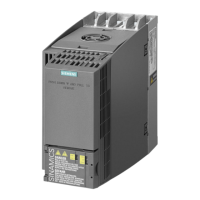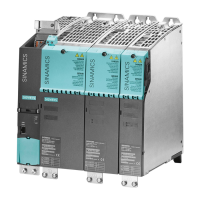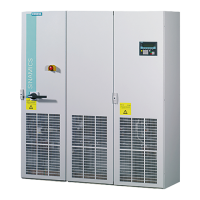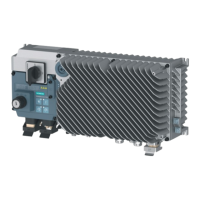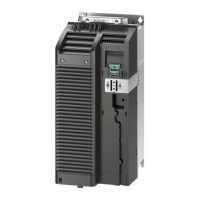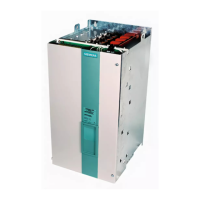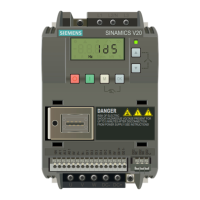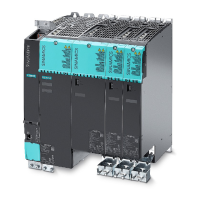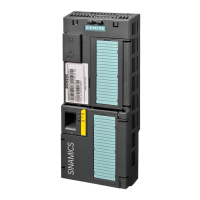SINAMICS S120 Cabinet Modules
Engineering Information
SINAMICS Engineering Manual – November 2015
Ó Siemens AG
460/528
such a level that the installed S120 Cabinet Modules can be operated within the specified pressure and volumetric
flow rate limits.
Pressure reduction by the ball valve is particularly important in cases where the volumetric flow rate required by the
S120 Cabinet Modules is significantly lower than the rated flow rate of the Heat Exchanger Module. This is because
the pressure drop at the heat exchanger of the Heat Exchanger Module is extremely low and practically all the
pressure generated by the pump constitutes a pressure difference between the inflow and return flow lines of the
deionized water circuit.
With a correctly dimensioned and calibrated cooling system, the typical temperature rise of the coolant in the
deionized water circuit between the inflow and return flow lines is approximately 6°C when the S120 Cabinet Modules
are operating under full load. The difference between the coolant temperature in the inflow line of the deionized water
circuit and the coolant temperature in the inflow line of the raw water circuit must be at least 7°C when the S120
Cabinet Modules are operating under full load.
7.3.4.6 Procedure of cooling circuit configuration
1. Calculating the required coolant temperature setpoint in the inflow line of the deionized water circuit
As a first step in configuring the cooling circuit, the minimum required setpoint T
set
of the coolant temperature in the
inflow line of the deionized water circuit must be determined. This is because the coolant temperature in the inflow
line must always be higher than the dew point of the air in order to protect the power units in the S120 Cabinet
Modules against condensation. The dew point of the air T
dp
is determined according to the maximum predicted
ambient temperature T
max
and the maximum predicted relative air humidity Φ
max
as specified in the table.
Ambient
temperature
T
Relative air humidity Φ
20 % 30 % 40 % 50 % 60 % 70 % 80 % 85 % 90 % 95 % 100 %
10 °C < 0 °C < 0 °C < 0 °C 0.2 °C 2.7 °C 4.8 °C 6.7 °C 7.6 °C 8.4 °C 9.2 °C 10.0°C
20 °C < 0 °C 2.0 °C 6.0 °C 9.3 °C 12.0°C 14.3°C 16.4°C 17.4°C 18.3°C 19.1°C 20.0°C
25 °C 0.6 °C 6.3 °C 10.5°C 13.8°C 16.7°C 19.1°C 21.2°C 22.2°C 23.2°C 24.1°C 24.9°C
30 °C 4.7 °C 10.5°C 14.9°C 18.4°C 21.3°C 23.8°C 26.1°C 27.1°C 28.1°C 29.0°C 29.9°C
35 °C 8.7 °C 14.8°C 19.3°C 22.9°C 26.0°C 28.6°C 30.9°C 32.0°C 33.0°C 34.0°C 34.9°C
40 °C 12.8°C 19.1°C 23.7°C 27.5°C 30.6°C 33.4°C 35.8°C 36.9°C 37.9°C 38.9°C 39.9°C
45 °C 16.8°C 23.3°C 28.2°C 32.0°C 35.3°C 38.1°C 40.6°C 41.8°C 42.9°C 43.9°C 44.9°C
50 °C 20.8°C 27.5°C 32.6°C 36.6°C 40.0°C 42.9°C 45.5°C 46.6°C 47.8°C 48.9°C 49.9°C
Approximately 4°C must be added to the dew point T
dp
as a safety margin in order to achieve the minimum coolant
temperature setpoint T
set
in the inflow line of the deionized water circuit.
T
set
= T
dp
(T
max
and Φ
max
according to table) + 4 °C
The calculated coolant temperature setpoint T
set
in the inflow line of the deionized water circuit must be set on the
control system of the Heat Exchanger Module during commissioning. The control system uses the 3-way valve
(bypass valve) in the deionized water circuit of the Heat Exchanger Module to keep the setpoint constant.
2. Calculating the current derating factor of the power units required by the temperature conditions
The maximum predicted ambient temperature T
max
and the coolant temperature setpoint T
set
in the inflow line of the
deionized water circuit (calculated above) must be within the permissible range of the relevant current derating
characteristics taking into account the degree of protection of the unit in question. If the characteristics are below
100 % for one or both of the temperatures, the relevant current derating factors must be applied when the electrical
dimensioning of all S120 Cabinet Modules is done.
Note:
The current derating factors of the two charts must not be multiplied. For dimensioning purposes, it is the least
favorable derating factor of the two charts that applies which means that a total derating factor of 0.9 is applicable
under worst-case conditions.

